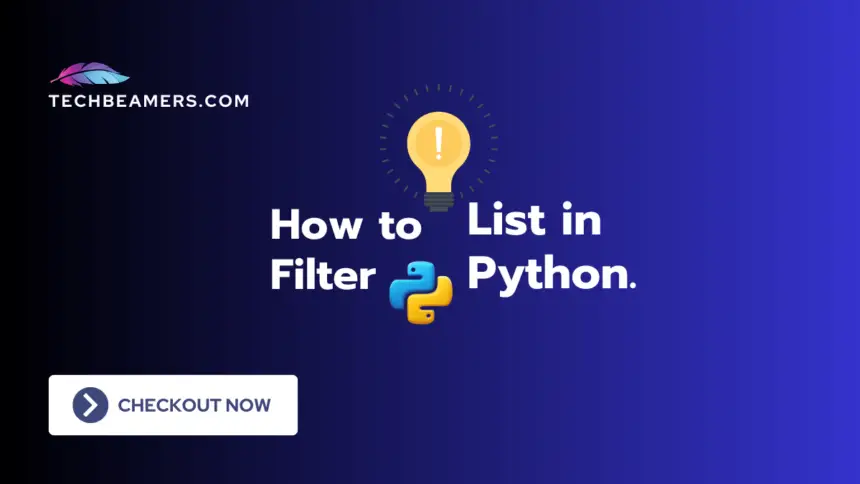In this tutorial, we’ll explain different methods to filter a list in Python with the help of multiple examples. You’ll learn to use the Python filter() function, list comprehension, and also use Python for loop to select elements from the list.
Filter a List in Python With the Help of Examples
As we know there are several ways to filter a list in Python, each with its specific advantages and complexity. So, firstly, let’s check out the most obvious option which is the Python filter() function.
1. Using the filter() function
This is the most common and efficient way to filter a list. It takes two arguments: a function that determines whether to keep an element (it should return True or False) and the list to filter. The filter() function returns an iterator for the elements that satisfy the condition.
nums = [11, 22, 31, 42, 51]
def is_num_odd(z):
return z % 2 != 0
out_nums = filter(is_num_odd, nums)
# Convert the iterator to a list
out_nums = list(out_nums)
print(out_nums)
# Output: [11, 31, 51]2. Using list comprehension
This is a concise way to filter and transform a Python list in one line. It’s more flexible than filter() but slightly less efficient.
nums = [11, 22, 31, 42, 51]
result = [x for x in nums if x % 2 == 0]
print(result)
# Output: [22, 42]3. Using a loop
This is the least efficient method but can be helpful for simpler tasks.
nums = [11, 22, 31, 42, 51]
outNums = []
for n in nums:
if n % 2 == 0:
outNums.append(n)
print(outNums)
# Output: [22, 42]4. Using other built-in functions
Several other built-in functions can be used for specific filtering tasks, like min(), max(), or any().
Choosing the right method:
- For simple filtering conditions, use
list comprehensionor a loop. - For more complex conditions or reusable filters, use the
filter()function. - For specific tasks like finding the minimum or maximum, use the appropriate built-in function.
Remember to consider the efficiency and clarity of your Python code when choosing a method to filter the list.
Understand the Filtering of List By Examples
Let’s try to understand more about filtering in Python beyond basic number examples. Let’s explore some unique scenarios:
1. Extracting specific data from a list of dictionaries:
Imagine you have a list of customer orders containing dictionaries with items like name, email, and order details. You want to filter for orders placed in a specific city:
orders = [
{"name": "Alice", "email": "alice@example.com", "city": "London"},
{"name": "Bob", "email": "bob@example.com", "city": "Paris"},
{"name": "Charlie", "email": "charlie@example.com", "city": "Tokyo"},
]
london_orders = [order for order in orders if order["city"] == "London"]
print(london_orders)
# Output: [{'name': 'Alice', 'email': 'alice@example.com', 'city': 'London'}]2. Filtering based on custom logic
Suppose you have a list of reviews for a movie, each with a rating and text. You want to filter for positive reviews with keywords related to “humor” or “acting”:
reviews = [
{"rating": 4, "text": "Hilarious! I laughed so much."},
{"rating": 3, "text": "Good plot, but predictable ending."},
{"rating": 5, "text": "A masterpiece of acting and storytelling."},
]
positive_humorous_reviews = [review for review in reviews if review["rating"] > 3 and ("laugh" in review["text"] or "acting" in review["text"])]
print(positive_humorous_reviews)
# Output: [{'rating': 4, 'text': 'Hilarious! I laughed so much.'}, {'rating': 5, 'text': 'A masterpiece of acting and storytelling.'}]3. Filtering using regular expressions
You can filter based on complex patterns using regular expressions. For example, extracting email addresses from a list of text entries:
import re
texts = [
"My email is johndoe@example.com.",
"Contact me at johnsmith123@gmail.com",
"This website has no contact information."
]
emails = [re.findall(r"[\w.]+@\w+\.\w+", text) for text in texts]
print(emails)
# Output: [['johndoe@example.com'], ['johnsmith123@gmail.com']]These are just a few examples, and the possibilities are endless! You can adapt these techniques to filter various data structures and apply custom logic to specific situations.
We hope the above examples and explanation would have been helpful! If you have any specific task in mind, feel free to ask using the comment box.
Comparing Methods for Filtering Lists in Python
| Method | Example | Advantages | Disadvantages |
|---|---|---|---|
filter() function | result = filter(lambda x: x%2 == 0, num_list) | – Efficient for complex conditions or reusable filters – Concise and readable | – Not as efficient as list comprehension for simple cases. – Requires defining a separate function. |
| List comprehension | | – Concise and efficient for simple filtering. | – Less flexible than filter() for complex conditions. – Can be less readable with complex logic. |
| Loop | | – Easiest to understand for beginners. | – Less efficient than filter() or list comprehension. – Longer and less readable for complex tasks. |
| Built-in functions | | – Highly efficient for specific tasks like finding min/max. – Built-in and easy to use. | – Limited to specific tasks. – Not suitable for more complex filtering criteria. |
Additional factors to consider:
- Memory usage:
filter()creates an iterator, requiring less memory than creating a new list with comprehension or a loop. - Readability: Choose the method that best suits the complexity of your code and makes it most understandable.
- Performance: For large datasets, filter() and list comprehension are generally faster than loops.
Ultimately, the best method depends on the use case and the complexity of your filtering criteria.
Summary
We have seen different ways to filter a list in Python, each has its pros and cons. Here’s a quick summary:
Main options:
filter()function: Powerful and efficient for complex conditions or reusable filters. Less efficient for simple cases. Requires defining a separate function.- List comprehension: Concise and efficient for simple filtering. Less flexible for complex conditions. Can be less readable with complex logic.
- Loop: Easy to understand but less efficient and cumbersome for complex tasks.
- Built-in functions: Highly efficient for specific tasks like finding min/max but limited to specific functionality.
Choosing the right one:
- Consider the complexity of your filtering criteria.
- Prioritize the readability and maintainability of your code.
- Performance matters:
filter()and list comprehension is generally faster for large datasets. - Memory usage:
filter()uses less memory than creating new lists.
No one-size-fits-all solution exists! Choose the method that best fits your coding task and makes your code clear and fast.
Remember, We are always here to help if you have any further questions or need clarification on specific filtering tasks!
Happy Coding,
Team TechBeamers









